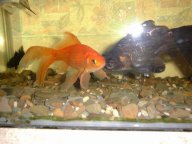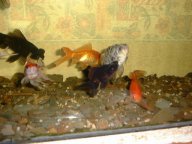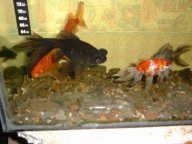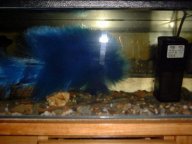Goldfish
Goldfish |
|
| Choosing pets can be a difficult task, especially if you are living alone or in an area where dogs and cats are not acceptable. It is not always possible to bring a dog, cat or even a budgie everywhere you go, and when the holidays come around, finding someone to look after them and make sure they are fed is not always possible. Many pets can very quickly destroy a home; chewing the furniture, dropping hair, feathers etc everywhere, and then there's the smells. |  |
| Goldfish are an ideal pet for those that live a busy lifestyle, are very low maintenance and, can enhance any room when set up properly. They don't make noise or leave nasty smells, you won't find any unwelcome surprises on the floor, your furniture is perfectly safe, they're easy to feed and slow releasing blocks of food are available for when you can't be there to look after them., |
What you need to set up an aquarium.
The first requirements are a tank, some gravel and a filter. I say tank because I'm
totally against keeping fish in a goldfish bowl. It is hard to oxygenate the water
properly, you need to change the water at least on a weekly basis, which is not good for
the fish, they offer very little room for the fish to swim properly, all of
the fish waste goes straight to the bottom. If this is not cleaned out very
regularly, you'll find some very sick, or even dead fish as rotting fish waste generates
some very harmful chemicals in the water.
Before running off to the pet shop to purchase your aquarium, think about what type of
fish you want and how many you would like to keep and how much space you have
available. There are hundreds of varieties of fish to choose from and they range
from very small to quite large. There are coldwater goldfish and tropical fish
requiring water heaters. Here I will only deal with coldwater fish. All
goldfish are a descendant of the gibel carp, which is found in Eastern Europe and
Asia. Goldfish have been bred in China for at least 2000 years. One breed of
the common carp, the Koi carp, was first cultivated in Japan. Koi are a large
ornamental fish usually patterned with stunningly bright colours. There are many
goldfish hybrids available and you should check with your local pet shop regarding the
size they are expected to grow to. Generally your tank should be able to hold approx
1 gallon of water per inch of fish.
When you have your aquarium, decide on where you want to locate it. They tend to be very heavy when filled and unless you have it on wheels, it will be difficult to move after it's set up. I know this because I have a 4 ft tank holding 25 gallons of water and I moved it recently. Make sure the surface you are going to place your aquarium on is flat and even, and that you have a cushioned or flexible mat under the tank before you fill it (cardboard, foam, etc). This will help to distribute the weight evenly and prevent the tank from cracking or breaking if the surface is slightly uneven. Also try to place it in an area that will not become too hot, such as over a radiator or fire, and not in direct sunlight. Rapid heating and cooling of the water will cause the fish to become unwell. The water should be kept around normal room temperature.
Once you are happy with the position, rinse the gravel well and put it into the tank and fill it with water. Water taken direct from your normal water supply should be good enough but leave it for a day or two to allow the water to get up to room temperature and for the chlorine to evaporate. At this stage you should have a filter set up and running in the tank. There are many types of filters available and any good pet shop should have several types available. I prefer to use the Fluval filters. There are a range of sizes to suit most tanks, and they are quite effective and easy to maintain. They do require a power supply, so this should be taken into consideration when deciding where to put the tank.
 |
There are hundreds of varieties, colours and shapes to choose from. |
Buying your fish
When your water has been in the tank long enough and is at room temperature, purchase your
fish. If you are interested in breeding fish, I will describe the best way of sexing
them later. For now we'll just buy the fish as pets. Select fish that are most
pleasing to the eye, as you might be looking at them for a very long time (hopefully).
Try to find out what the expected growth will be. Most fish will restrict
their own growth to suit their environment but, there are those that don't. Try to
buy the fish in pairs if possible. They will settle in better if there is a familiar
fish with them. Contrary to the belief of some, fish are not dumb creatures and they
do have quite a memory span. They can also recognise familiar objects and feeding
times.
 |
Normally, your fish will be supplied in a plastic bag, approximately half filled with water. Don't buy the fish and then do the weeks shopping or go for a meal. The oxygen in the bag will last for quite a while, but they should be taken home as soon as possible. Place the bag, still tied, floating in the water in the tank for an hour or two. This will allow the temperature in the bag to equalise with the temperature in the tank, and will help prevent shock when you release the fish into the tank.
Looking after your fish
Now you have the fish at home, the next priority is to look after them properly.
Feed them with flake food in small quantities. Just a small pinch at a time, giving
them no more than they can eat in around five minutes. You can give them several
feeds a day but try not to overfeed. Too much food and it will settle in the bottom
of the tank and rot. The water then becomes polluted. Flake food is a good
choice as it usually contains all the components to ensure a well balanced diet and colour
enhancing additives. Try to clean out the filter once a week. Use only water
from the fish tank or, clean running water for this. NEVER use detergents or
bleaches. Detergents in any amount, no matter how small, will make the fish very
sick or even kill them. Around once a month, take some, not all. of the water from
the tank and top it up with clean water. Judge it by taking approx one inch of water
from the usual water level. This will freshen up the water in the tank. Every
couple of months or so, after your usual cleaning, stir up the gravel in the tank.
Allow the filter to run for approx 30 minutes, then clean the filter again. This
will release any waste deposits from the bottom of the tank and remove them from the
water.
Aquarium plants would be ideal in a situation where a filter cannot be used, as they do generate oxygen and use some of the fish waste. However, this does not rule out the need for a filter. Plants will oxygenate and filter the water to an extent. I've tried several plants in my own tank but the fish ate some of them, and others just fouled up the water and filter. You can also buy artificial plants which can be very realistic. There is also a seemingly endless range of ornaments specially designed for fish tanks. You can also buy specialised posters, which go at the back of your aquarium, giving a realistic undersea look to it. Fully equipped aquariums can look very attractive and create a perfect show piece in any room. Some people even find watching fish to be very relaxing.
Fish breeding
If you want to try breeding some fish, then you will need to know whether you have at
least one male and one female. I was told on numerous occasions that sexing fish is
impossible unless you actually see the female laying eggs. Not true. If you
want to know which is which, look at the gills and tail of each fish. The male will
have slightly raised white spots on his gills, usually coming out around the time he's
ready to breed. These spots will also be barely noticeable on his tail and
fins. On the orange coloured fish they are usually easy enough to see, but on
speckled or mutli-coloured fish, a very close inspection may be required and they can be
very hard to see. The female may or may not show signs she is ready to lay
eggs. Her stomach may swell slightly, but this is not always the case, or at least
is not always noticeable. A good sign that they are ready to breed is to watch their
behaviour towards each other. Goldfish do not have intercourse in the way that most
other animals. They may seem to be displaying aggression towards each other, or at
least, one may seem more aggressive. This is the male rubbing against the female
trying to stimulate her to lay eggs. You will see him chasing her around the tank
with his nose stuck under her tail. This is quite normal. The closer she comes
to laying, the more aggressive they seem to become. Don't worry and don't separate
them.
 |
Male chinese carp. You can just make out the white spots on the gills and also along the underside and top of the tail. This fish is over ten years old. |
Care should now be taken, as, in the absence of plants, she may try to lay her eggs in or around the filter. I've found an excellent remedy, which is simply a nylon brush (pictured below), used for dusting around the house (use a new one). Cut off the handle and tie the brush to a stone (washed of course) heavy enough to keep it on the bottom. Now keep an eye on the brush, checking every morning and evening for the eggs which can be very small and hard to see. As I type this I have new fish emerging. I took the brush from the main tank and placed it in a smaller tank to prevent the other fish from eating the eggs. Once the eggs are laid the male will swim excitedly around them and spray his milt (sperm) onto them. These will usually hatch within three to five days and will look like tiny tadpoles. For the first few days, they will attach themselves to the glass or plants, or anything else available in the tank. This is their natural instinct. In the wild, newly hatched carp will attach themselves to leaves etc, to avoid being seen and eaten by predators, so don't expect to see much movement for a while. The fry will initially live off microscopic food particles in the water. When they reach about 2 cm long, they will start to look like the parents. It is not a good idea to have a filter running once fry have emerged. The intake current can be quite strong and they tend to get sucked in. It might be a good idea to keep them in a separate container away from larger fish until they are big enough,(around 2 - 3 cm) and strong enough to avoid getting sucked in to the filter or being eaten. Introduce them slowly into the larger tank. Floating nursery tanks are available as well as multi-purpose traps, used for breeding, displaying etc, and can hang inside the main tank and allow the tank water to run through them. It should be noted however, when the eggs are laid there could be very large amounts (anything from approx 30 to over 100 eggs). You should consider whether you will have the space for the resulting fish, or be able to pass them on to someone else. Or, if you're very lucky, sell them. Some pet stores will either buy, or trade young fish off equipment. It's not fair to hatch out fish only to kill them off because you don't have the room for them. It would be better to only save some of the eggs and dispose of the rest.
 |
This is the brush inside the small tank. The new fish are too small to show up yet. To the right is a Fluval 1 filter. |